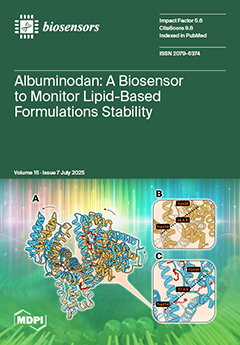In clinical applications of surface-enhanced Raman spectroscopy (SERS) immunosensors, accurately determining analyte biomarker concentrations is essential. This study presents a non-invasive approach for quantifying various breast cancer biomarkers—including human epidermal growth factor receptor II (HER-II) (2+, 3+ (I), 3+ (II), 3+ (III), and
[...] Read more.
In clinical applications of surface-enhanced Raman spectroscopy (SERS) immunosensors, accurately determining analyte biomarker concentrations is essential. This study presents a non-invasive approach for quantifying various breast cancer biomarkers—including human epidermal growth factor receptor II (HER-II) (2+, 3+ (I), 3+ (II), 3+ (III), and positive IV) and CA 15-3—using a directional, plasmonically active, label-free SERS sensor. Each stage of sensor functionalization, conjugation, and biomarker interaction was verified by UV–Vis spectroscopy. Atomic force microscopy (AFM) characterized the morphology of gold nanourchin (GNU)-immobilized printed circuit board (PCB) substrates. An enhancement factor of ≈ 0.5 × 10
5 was achieved using Rhodamine 6G as the probe molecule. Calibration curves were initially established using standard HER-II solutions at concentrations ranging from 1 to 100 ng/mL and CA 15-3 at concentrations from 10 to 100 U/mL. The SERS signal intensities in the 620–720 nm region were plotted against concentration, yielding linear sensitivity with R
2 values of 0.942 and 0.800 for HER-II and CA15-3, respectively. The same procedure was applied to breast cancer serum (BCS) samples, allowing unknown biomarker concentrations to be determined based on the corresponding calibration curves. SERS data were processed using the
filtfilt filter from
scipy.signal for smoothing and then baseline-corrected with the Improved Asymmetric Least Squares (IASLS) algorithm from the
pybaselines.Whittaker library. Principal Component Analysis (PCA) effectively distinguished the sample groups and revealed spectral differences before and after biomarker interactions. Key Raman peaks were attributed to functional groups including N–H (primary and secondary amines), C–H antisymmetric stretching, C–N (amines), C=O antisymmetric stretching, NH
3+ (amines), carbohydrates, glycine, alanine, amides III, C=N stretches, and NH
2 in primary amides.
Full article






